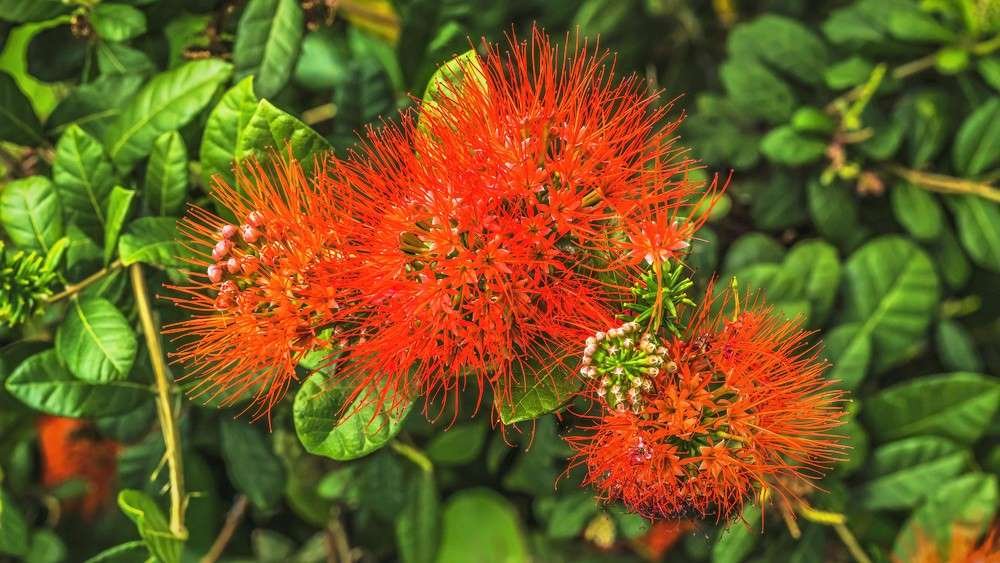Hawaii Island Flower: Metrosideros polymorpha (ʻōhiʻa lehua)
Hawaii, the 50th state of the United States of America, is renowned for its breathtaking scenery and vibrant culture. However, few may know that it has an official flower with a fascinating story. The Metrosideros polymorpha (ʻōhiʻa lehua), or Pua Lehua, is considered sacred by many in Hawaii and can often be seen growing on lava beds across the islands. This article will explore why this particular flower is Hawaii’s official floral emblem.
Overview Of The Hawaii Island Flower
- Scientific name: Metrosideros polymorpha
- Hawaiian name: ʻōhiʻa lehua
- Distribution: Sea level to 8000 feet elevation
- Habitat: Moist and dry forests
- Threats: Rapid Ohia Death (fungus), Wildfire, Damage from feral ungulates, Loss of pollinators, Myrtle rust, and Alien invasive species
- Metrosideros polymorpha, also known as ʻōhiʻa lehua, is a flowering evergreen tree endemic to Hawaii.
- It can grow up to 20-25m tall in favorable conditions or as a prostrate shrub in boggy soils.
- The tree produces a range of flowers that can be red, yellow, or other colors.
- It is the most common native tree in Hawaii, growing in various soil conditions, temperatures, and rainfall levels, from sea levels to elevations of 2,500m.
- It occurs as a tall tree or shrub, with acidic to neutral soil preferred (pH 3.6-7.4), with rainfall levels ranging from 400mm to 10,000mm per year.
- The reddish brown heartwood of the tree is hard and fine textured, used in construction and for making tools and weapons in native Hawaiian society.
- The wood burns hot and cleanly, making it excellent firewood.
- The lehua flowers have cultural significance in Hawaiian traditions and are sacred to Pele and Laka.
Sources: Wikipedia
‘Ohi’a lehua in culture
The ‘Ohi’a lehua is of great cultural importance in Hawaiian mythology. It is said to be sacred to Pele, the volcano goddess, and Laka, the goddess of hula. The story of ‘Ohi’a and Lehua is well-known: Pele fell in love with ‘Ohi’a, but he rejected her, so she transformed him into a tree. Not wanting to be separated, other gods turned Lehua into a flower on the ‘ohi’a tree. Another version has it that Pele felt remorseful and thus turned Lehua into a flower. People also believed that whenever a lehua flower is picked, it will cause rain in honor of the two lovers’ sorrow.
Traditionally, Hawaiian people used the tree’s wood for kapa beaters, poi boards, and weapons. They used the leaves as a medicinal tea but used flowers and young growth for lei and hula altar adornment.
Source: Hawaii.gov
Symbolism and Cultural Significance Of The Red Pua Lehua
‘Ohi’a Lehua holds a profound significance in Hawaiians’ culture and lives, symbolizing strong love and rebirth.
The traditional version of this flower is red pua lehua, typically found on trees at higher elevations around the islands. The bright color of the bloom symbolizes courage while also representing a solid connection with Native Hawaiian ancestors throughout generations.
The red pua lehua is the official flower of Hawaii, and it carries a deep cultural significance to its people. Like a beautiful gemstone among a pile of rocks, the red pua lehua stands out with its vibrant petals and sweet scent.
This flower symbolizes love, beauty, strength, and courage for Hawaiians – essential qualities in their everyday lives. It represents loyalty, faithfulness, and resilience when facing difficulties or adversity. The blossoming of this flower can bring hope even during dark times. Because of these values that it embodies, it has been used as an offering to Hawaiian gods since ancient times and is seen today at many ceremonies such as weddings or funerals.
In addition to being symbolic, the red pua lehua is also beloved for its aesthetic beauty: its delicate petals can reach up to 2 inches across and bloom from bright pink buds into fragrant blooms, which range from white to a deep crimson color. This flower’s natural habitat ranges from sea level up to 6500 feet on lava fields and rainforest slopes throughout the islands. Hence, it serves as a reminder of nature’s bounty wherever one may go in Hawaii.
Rapid ‘Ōhi’a Death
Rapid ‘Ōhi’a Death is a fungal infestation caused by Ceratocystis fimbriata. Trees infected with the fungus die quickly, all leaves turning brown and falling off within weeks.
The origin of this new strain of Ceratocystis fimbriata is unknown, but it transmits in wood, plants, and soil.
Currently, there is no cure, but quarantine restrictions on ‘ōhi’a transport allow researchers time to search for solutions. The disease can kill ‘ōhi’a trees statewide and harm native forests and watersheds.
The latest map shows confirmed cases spreading from Puna and South Hilo to Volcano, Na‘alehu, and Kona.
The disease does not affect other trees such as kōpiko, ‘ohe mauka, strawberry guava, Melastoma spp., and Koster’s curse.
The fungus may be spread by wind-blown insect frass or by attacking already diseased trees.
A quarantine has been imposed by the Hawai’i Department of Agriculture, prohibiting the movement of ‘ōhi’a plants or parts without a permit. Violating the quarantine is a misdemeanor, with fines up to $10,000 and hearings underway to make it a permanent rule.
Reduce the spread of Rapid Ohia Death
- Please don’t move the wood from one area to another, as it may spread.
- Don’t transport it off the island without a permit (there are quarantine rules in place to prevent ROD spreading)
- Clean your chainsaw and tools: Mixing 70% rubbing alcohol and 10% bleach can kill the fungus, but may corrode your gear, so oil it afterward.
- Clean your gear: Especially your shoes, gear, and clothing. You can dip the soles of the shoes in the 70% alcohol + 10% bleach mixing solution, and you can wash your clothes in hot water with detergent.
- Wash your vehicle, the tires, and the undercarriage if you have been driving off-road or through an area with ROD.
Source: Hawaii.gov

